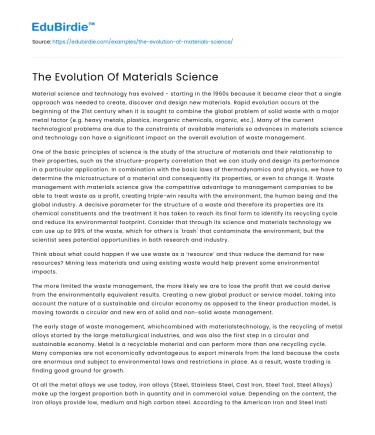Material science and technology has evolved - starting in the 1960s because it became clear that a single approach was needed to create, discover and design new materials. Rapid evolution occurs at the beginning of the 21st century when it is sought to combine the global problem of solid waste with a major metal factor (e.g. heavy metals, plastics, inorganic chemicals, organic, etc.). Many of the current technological problems are due to the constraints of available materials so advances in materials science and technology can have a significant impact on the overall evolution of waste management.
One of the basic principles of science is the study of the structure of materials and their relationship to their properties, such as the structure-property correlation that we can study and design its performance in a particular application. In combination with the basic laws of thermodynamics and physics, we have to determine the microstructure of a material and consequently its properties, or even to change it. Waste management with materials science give the competitive advantage to management companies to be able to treat waste as a profit, creating triple-win results with the environment, the human being and the global industry. A decisive parameter for the structure of a waste and therefore its properties are its chemical constituents and the treatment it has taken to reach its final form to identify its recycling cycle and reduce its environmental footprint. Consider that through its science and materials technology we can use up to 99% of the waste, which for others is 'trash' that contaminate the environment, but the scientist sees potential opportunities in both research and industry.
Save your time!
We can take care of your essay
- Proper editing and formatting
- Free revision, title page, and bibliography
- Flexible prices and money-back guarantee
Think about what could happen if we use waste as a ‘resource’ and thus reduce the demand for new resources? Mining less materials and using existing waste would help prevent some environmental impacts.
The more limited the waste management, the more likely we are to lose the profit that we could derive from the environmentally equivalent results. Creating a new global product or service model, taking into account the nature of a sustainable and circular economy as opposed to the linear production model, is moving towards a circular and new era of solid and non-solid waste management.
The early stage of waste management, whichcombined with materialstechnology, is the recycling of metal alloys started by the large metallurgical industries, and was also the first step in a circular and sustainable economy. Metal is a recyclable material and can perform more than one recycling cycle. Many companies are not economically advantageous to export minerals from the land because the costs are enormous and subject to environmental laws and restrictions in place. As a result, waste trading is finding good ground for growth.
Of all the metal alloys we use today, iron alloys (Steel, Stainless Steel, Cast Iron, Steel Tool, Steel Alloys) make up the largest proportion both in quantity and in commercial value. Depending on the content, the iron alloys provide low, medium and high carbon steel. According to the American Iron and Steel Institute (AISI), an iron carbon alloy is considered to be steel if the carbon level is between 0.01% and 2.00%, and is the most recyclable material on the planet and the rest of the metals are equally which are a high cost waste “resource”. Metals have the highest value, followed by paper and plastic.
These economic benefits focus on the value of the materials recovered through recycling. The Turnover for the recycling project of the most important materials almost doubled between 2004 and 2008 in the European Union (from € 32.5 billion to € 60.5 billion) to drop to € 37.2 billion in 2009 due to the economic downturn, remaining but at higher levels than five years ago. Recycling is a key to achieving EU strategy to move to an economy where it makes the most of its natural resources, but the value is not only economic, it is environmental and social. Uncontrolled waste disposal increases the greenhouse effect. Wastes such as batteries and electrical and electronic items contain hazardous substances such as lead, mercury, cadmium, etc. that spillover into the environment has an impact on soil, water, organisms, and even humans with harmful effects on public health. Recycling is crucial to creating new jobs. Collection, sorting, processing, disassembly, etc. employ more workers than waste landfill. Depending on the material and country, it is estimated that recycling the same amount of waste creates 6 to 10 times more jobs than burial or burning. In the EU it has been estimated that recycling workers increased from 230,000 in 2000 to 512,000 in 2008, an increase of 10.57% per year. This increase was the second largest in the eco-industry after the renewable energy sector. Particularly for Greece, recycling is estimated to contribute to some 3,600 full-time jobs.
Communication and dissemination of information on the new economic waste trading model is a key element in the implementation of European environmental actions. Phenomena such as 'NIMBY, Not in my Backyard' are prevalent and can lead to significant delays and even cancellations due to bad public thoughts. So let's give science and management a last chance to provide a solution with multiple benefits for both humans and industry but also for this ecosystem that surrounds us.






 Stuck on your essay?
Stuck on your essay?

